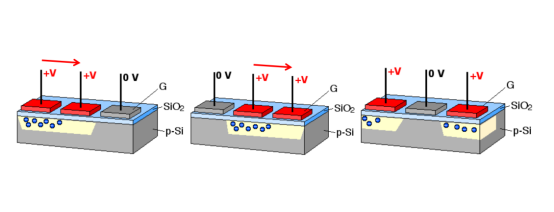
In the electronic components industry, Charge-Coupled Devices (CCDs) have become a key area of interest and exploration. This article delves into the definition, working principles, characteristics, advantages, and applications of CCDs.
Catalog
I. What are Charge-Coupled Devices?
III. Characteristics and Advantages
I. What are Charge-Coupled Devices?
A charge-coupled device (CCD) is an integrated circuit featuring a grid of closely packed capacitors that can sense light and convert images into digital signals. By using external circuitry to control each capacitor, the charge can be transferred to its neighboring capacitors. The CCD uses charge transfer technology to convert light signals into charges, which are read out sequentially through charge transfer.
II. Working Principle
A light-sensitive CCD contains a sensitive area (an epitaxial layer of silicon) and a shift register area (in a strict sense, the CCD). An image is projected onto an array of capacitors (the sensitive area) through a lens, causing each capacitor to accumulate charge proportional to the intensity of the incident light. One-dimensional capacitor arrays are used in line-scan cameras, where a single layer of capacitors can be scanned at a time. Two-dimensional arrays in video cameras and digital cameras allow for the capture of images projected onto the focal plane. After exposure, a control loop enables each capacitor to pass its charge to the next, culminating in the charge of the last capacitor being sent to a charge amplifier and converted into a voltage signal. This process converts the entire array's charge into a series of voltage signals. In digital circuits, these signals are sampled and digitized, often stored for future use. In analog circuits, they can be processed into continuous analog signals (e.g., feeding the charge amplifier's output to a low-pass filter).

In short, when light hits the CCD's light-sensitive area, photons excite electrons in the semiconductor, creating charge. These charges are collected in the pixel storage areas and read out sequentially through charge transfer. The charges are then converted to voltage signals, generating the image.
III. Characteristics and Advantages
· High Sensitivity: CCDs offer excellent photoelectric conversion efficiency, capturing faint light signals.
· Low Noise: CCDs produce clear, detailed images due to their high signal-to-noise ratio.
· High Resolution: CCDs capture fine image details, offering high-quality image output.
IV. Applications
CCD sensors are used in digital cameras, optical scanners, and video cameras as their light-sensitive components. Their light efficiency can reach up to 70% (capturing 70% of incident light), far superior to traditional film at 2%, which has made CCDs a favorite among astronomers.
In astronomy, CCD sensors are widely used for astronomical observations and astrophotography. Thanks to their high sensitivity and low noise, CCD sensors can capture faint light signals from distant celestial bodies and provide high-quality images. CCDs can even mimic the functionality of a tracking telescope with a stationary telescope, adjusting the charge transfer direction and speed to match the celestial body's movement, thereby correcting tracking errors and allowing the telescope to capture larger fields of view.
In scientific research, CCD sensors are used in spectroscopy, microscopy, and experimental measurement. Scientists use CCD sensors to capture and record light signals generated during experiments, thus obtaining experimental data and conducting analyses. Their high sensitivity and reliability make CCD sensors indispensable tools in scientific research.
V. CCDs vs. CMOS Sensors
CCDs and CMOS sensors are two primary imaging technologies in the digital imaging domain. They differ significantly in working principles, features, and applications.
First, CCD sensors use charge transfer technology to convert light signals into charges and read them out sequentially. In contrast, CMOS sensors convert light signals directly into voltage signals. Each pixel in a CMOS sensor has its own amplifier and analog-to-digital converter, enabling parallel reading. This means CMOS sensors can capture images faster, especially advantageous for high-speed continuous shooting and video recording.
However, CCD sensors excel in terms of low noise and high sensitivity. Due to their charge transfer technology, CCD sensors produce less noise during the light signal conversion process, resulting in clearer and more detailed images. As such, CCD sensors remain the top choice for applications requiring high image quality, such as astronomy and medical imaging.
VI. Conclusion
As technology advances, CCDs face new challenges and opportunities. The emergence of new imaging technologies, such as CMOS sensors, presents competition for CCDs. Nonetheless, CCDs maintain irreplaceable advantages in specific fields, such as low noise and high sensitivity. Looking ahead, as image quality and performance requirements continue to rise, CCDs will remain vital and work alongside new technologies to drive the progress of the digital imaging field.




